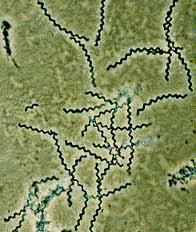Not for the Faint of Heart
A graduate school friend of mine, with her husband, just started a new storytelling site called YouShare. I was thrilled when they asked me to write a story about my 2008 health crisis. I’d recently finished a full book proposal and sample chapter for a memoir on the topic, and I’d been thinking about turning my focus to shorter pieces about the event. You can read the essay on YouShare (please heart the story!) or read it below. YouShare is a wonderful venue for people around the world to share their stories. Do you have a story to share?
Lyme Disease: Not for the Faint of Heart
Imagine this: a hidden bacterium that slowly proliferates, spreading through your tissues and organs and joints, hiding in your brainstem, affecting your mood and digestion and sleep, and in some cases your heart. Now, imagine this: a small group of physicians with business and research interests who, instead of focusing on patient realities, do their best to silence the voices of those who become bedridden, disabled, and forever changed by this bacteria. Not only do they belittle and marginalize the patients, but also they attack the professionalism of the physicians who clinically treat these patients and the researchers who attempt to shed new light on the understanding of the bacterium.
This is the reality of Lyme disease, which is sometimes referred to as Lyme Complex or Borreliosis.
I had just turned forty when I woke one night, unable to breath, gasping for air. It felt as if that proverbial elephant had embedded its foot in my chest. I stumbled out of bed and made my way to the front door. Soon the ambulance was in my driveway and I was being wheeled down our flagstone path on a gurney, the stillness of the dark night sky broken by silent and flashing red lights. This journey away from my house, away from my sleeping daughters, with my husband following behind in his car, was the beginning of my fall down the rabbit hole of Lyme disease.
This is what I knew about Lyme disease before that night: if you find a tick on you, remove it and wait to see if you get a round, red rash and fever. If you don’t see the rash, you don’t have Lyme disease. But I, like so many others, was naïve.
The emergency room doctor ensured that I was stabilized, but made it clear that that was his only job. Despite an irregular chest x-ray and irregular blood work, he sent me home. For three months my health deteriorated. I started fainting in yoga, my once 20/20 vision disappeared so that the external world became an impressionistic painting –my daughters’ faces blurry and unclear, trees and bushes indistinguishable shapes—and I began to have seizures. Soon, I lost over twenty pounds. I was 95 pounds, my ribs protruding through my shirts, my pants falling down my hips. And my brain could not process the sensory input from a moving car and the shifting landscape outside my window, or the bright lights and noise of a grocery store. I was trapped inside a failing body and a confused mind. And the worst part? None of the doctors knew what was causing my sudden decline.
In the few weeks leading up to my ambulance ride, I had had a high fever, sudden overwhelming fatigue, and I had been taking care of two of my daughters who had the flu. My eyes had been rimmed in dark circles and my periods had become erratic. What the doctors did find in the three months of deterioration following that first ambulance ride was that I had thyroiditis, interstitial markings on a chest x-ray (congestive heart failure), mild pulmonary hypertension, and my ovarian hormones were a mess. It would take a committed, out-of-state physician and copious amounts of blood work to finally piece it all together, to literally stitch me back together.
This is what I now know: I had suffered a Lyme crisis. After my health was stabilized I was left with the effects from a mild stroke, premature ovarian failure and neurally mediated hypotension—I’m part of the 10% of people with NMH caused by a rare autoimmune condition, an autoimmune condition that the tiny little bacterium, the spirochete Borrelia burgordorferi triggered while stealthily moving through my body undetected. And persistent infection from multiple tick-borne pathogens means for many ongoing vigilance and treatment.
This is what else I know: some people are genetically wired to get really, really sick from Lyme. This doesn’t make them crazy or a hypochondriac. What it does mean is that clinicians evaluating rapidly declining patients with a confusing array of neurological, hormonal, or cardiac symptoms need to pay attention. They need to rely upon the art of medicine through clinical inquiry and diagnosis, and they need to learn humility in the face of B. burgordorferi.
It’s been seven years since my life was turned upside down by my Lyme crisis. The two and a half months that I was having constant seizures, is a time period that brought me many spiritual and emotional gifts. My faith in medicine, in the hallowed halls of Ivy League institutions was broken. My understanding of myself as a woman, as a daughter, as a mother and wife, as a patient in an inherently flawed system of medicine, changed dramatically. When I close my eyes and envision that time, I see my old, Lyme-naïve-self set aflame and crumbling in ashes, so that a new self could emerge. A new self with a strength of character and a confidence in my own intuitive knowing, which were only glimmers beforehand. The challenge of finding good care, of battling many, many close-minded and misogynistic practitioners, of caring for my family while daily walking through a neurological maze both frightening and confusing, was immense.
Here’s what the physicians who tried to prescribe me antidepressants and benzos didn’t understand about the woman they perceived as a “stressedoutmiddleagedmotheroffour.” It was because of my four daughters—four emerging young women who will one day be middle aged themselves—that I persevered and found answers. It was because of those daughters—who I left behind when I rode in that ambulance in the middle of the night on that first night of my crisis—that I now simply smile and walk away when I hear a practitioner’s misguided and lazy comments.
In Lyme disease, there are still so many unknowns. Still so much research needed to be done. And no, if you’re bitten by a tick and a red round “bull’s eye” rash doesn’t develop, it doesn’t mean that you don’t have Lyme disease. The spirochete is brilliant really. It can evade and confuse the smartest of immune systems. And it loves the juicy, grey matter of the brain. Lyme disease is complex. And it’s not for the faint of heart.
Throughout my crisis and the ensuing years of finding health again, I gained a profound respect for my mortality. I gained an awareness of the fragility of life. And, conversely, an expansive awareness of beauty found in the smallest of moments: in a small gesture of generosity, in a kind word, in a morning when the birds are singing and the sky is blue and the trees are bending and dancing in a gentle breeze. I feel acutely the fierceness of the ocean and the majesty of the steep and jagged red rock of the southwest. I’ve watched my old life burn and I’ve built a new life from the ashes. I now step with an increased sense of humility and gratitude.
Most of all, in fighting Lyme and its far-reaching effects, I’ve learned courage and perseverance.
Now imagine this: a patient presents to a physician with a sudden onset of joint pain, a strange rash, and palpitations. Soon the patient reports GI distress, dizziness, and fatigue. The physician calls on a specialty team to evaluate the patient for tick borne disease. They know that antibody testing is only effective in those patients with strong immune systems, so they run comprehensive blood work and take a detailed history, and they follow a hunch that tick borne disease may have been quietly spreading throughout the woman’s body for years. A recent virus in the house seemingly triggered the woman’s immune system into a hyper state. Given the sheer numbers of patients affected by tick borne disease, of which Lyme is just one, research institutes have by now devoted large amounts of money to state of the art study, and the woman, once effectively evaluated and started on treatment, has the support of a fully informed community and multi-disciplinary team of care providers to guide her through the difficult treatment.
And that small group of physicians who currently control the research for their own business interests? As my German great-grandmother often said with a sharp, disapproving, click of her tongue, “ACK!”



